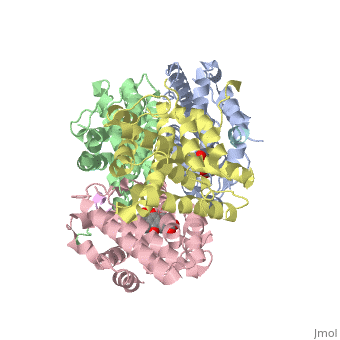3r2a: Difference between revisions
No edit summary |
No edit summary |
||
| (One intermediate revision by the same user not shown) | |||
| Line 1: | Line 1: | ||
==Crystal structure of RXRalpha ligand-binding domain complexed with corepressor SMRT2 and antagonist rhein== | ==Crystal structure of RXRalpha ligand-binding domain complexed with corepressor SMRT2 and antagonist rhein== | ||
<StructureSection load='3r2a' size='340' side='right' caption='[[3r2a]], [[Resolution|resolution]] 3.00Å' scene=''> | <StructureSection load='3r2a' size='340' side='right'caption='[[3r2a]], [[Resolution|resolution]] 3.00Å' scene=''> | ||
== Structural highlights == | == Structural highlights == | ||
<table><tr><td colspan='2'>[[3r2a]] is a 6 chain structure with sequence from [ | <table><tr><td colspan='2'>[[3r2a]] is a 6 chain structure with sequence from [https://en.wikipedia.org/wiki/Homo_sapiens Homo sapiens]. Full crystallographic information is available from [http://oca.weizmann.ac.il/oca-bin/ocashort?id=3R2A OCA]. For a <b>guided tour on the structure components</b> use [https://proteopedia.org/fgij/fg.htm?mol=3R2A FirstGlance]. <br> | ||
</td></tr><tr id=' | </td></tr><tr id='method'><td class="sblockLbl"><b>[[Empirical_models|Method:]]</b></td><td class="sblockDat" id="methodDat">X-ray diffraction, [[Resolution|Resolution]] 3Å</td></tr> | ||
<tr id=' | <tr id='ligand'><td class="sblockLbl"><b>[[Ligand|Ligands:]]</b></td><td class="sblockDat" id="ligandDat"><scene name='pdbligand=RHN:4,5-DIHYDROXY-9,10-DIOXO-9,10-DIHYDROANTHRACENE-2-CARBOXYLIC+ACID'>RHN</scene></td></tr> | ||
<tr id='resources'><td class="sblockLbl"><b>Resources:</b></td><td class="sblockDat"><span class='plainlinks'>[https://proteopedia.org/fgij/fg.htm?mol=3r2a FirstGlance], [http://oca.weizmann.ac.il/oca-bin/ocaids?id=3r2a OCA], [https://pdbe.org/3r2a PDBe], [https://www.rcsb.org/pdb/explore.do?structureId=3r2a RCSB], [https://www.ebi.ac.uk/pdbsum/3r2a PDBsum], [https://prosat.h-its.org/prosat/prosatexe?pdbcode=3r2a ProSAT]</span></td></tr> | |||
<tr id='resources'><td class="sblockLbl"><b>Resources:</b></td><td class="sblockDat"><span class='plainlinks'>[ | |||
</table> | </table> | ||
== Function == | == Function == | ||
[ | [https://www.uniprot.org/uniprot/RXRA_HUMAN RXRA_HUMAN] Receptor for retinoic acid. Retinoic acid receptors bind as heterodimers to their target response elements in response to their ligands, all-trans or 9-cis retinoic acid, and regulate gene expression in various biological processes. The RAR/RXR heterodimers bind to the retinoic acid response elements (RARE) composed of tandem 5'-AGGTCA-3' sites known as DR1-DR5. The high affinity ligand for RXRs is 9-cis retinoic acid. RXRA serves as a common heterodimeric partner for a number of nuclear receptors. The RXR/RAR heterodimers bind to the retinoic acid response elements (RARE) composed of tandem 5'-AGGTCA-3' sites known as DR1-DR5. In the absence of ligand, the RXR-RAR heterodimers associate with a multiprotein complex containing transcription corepressors that induce histone acetylation, chromatin condensation and transcriptional suppression. On ligand binding, the corepressors dissociate from the receptors and associate with the coactivators leading to transcriptional activation. The RXRA/PPARA heterodimer is required for PPARA transcriptional activity on fatty acid oxidation genes such as ACOX1 and the P450 system genes.<ref>PMID:10195690</ref> <ref>PMID:11162439</ref> <ref>PMID:11915042</ref> <ref>PMID:20215566</ref> | ||
==See Also== | ==See Also== | ||
*[[Retinoid X receptor|Retinoid X receptor]] | *[[Nuclear receptor corepressor|Nuclear receptor corepressor]] | ||
*[[Retinoid X receptor 3D structures|Retinoid X receptor 3D structures]] | |||
== References == | == References == | ||
<references/> | <references/> | ||
__TOC__ | __TOC__ | ||
</StructureSection> | </StructureSection> | ||
[[Category: | [[Category: Homo sapiens]] | ||
[[Category: Chen | [[Category: Large Structures]] | ||
[[Category: Chen | [[Category: Chen J]] | ||
[[Category: Jiang | [[Category: Chen L]] | ||
[[Category: Shen | [[Category: Jiang H]] | ||
[[Category: Zhang | [[Category: Shen X]] | ||
[[Category: Zhang H]] | |||
Latest revision as of 15:07, 14 March 2024
Crystal structure of RXRalpha ligand-binding domain complexed with corepressor SMRT2 and antagonist rheinCrystal structure of RXRalpha ligand-binding domain complexed with corepressor SMRT2 and antagonist rhein
Structural highlights
FunctionRXRA_HUMAN Receptor for retinoic acid. Retinoic acid receptors bind as heterodimers to their target response elements in response to their ligands, all-trans or 9-cis retinoic acid, and regulate gene expression in various biological processes. The RAR/RXR heterodimers bind to the retinoic acid response elements (RARE) composed of tandem 5'-AGGTCA-3' sites known as DR1-DR5. The high affinity ligand for RXRs is 9-cis retinoic acid. RXRA serves as a common heterodimeric partner for a number of nuclear receptors. The RXR/RAR heterodimers bind to the retinoic acid response elements (RARE) composed of tandem 5'-AGGTCA-3' sites known as DR1-DR5. In the absence of ligand, the RXR-RAR heterodimers associate with a multiprotein complex containing transcription corepressors that induce histone acetylation, chromatin condensation and transcriptional suppression. On ligand binding, the corepressors dissociate from the receptors and associate with the coactivators leading to transcriptional activation. The RXRA/PPARA heterodimer is required for PPARA transcriptional activity on fatty acid oxidation genes such as ACOX1 and the P450 system genes.[1] [2] [3] [4] See AlsoReferences
|
| ||||||||||||||||||
